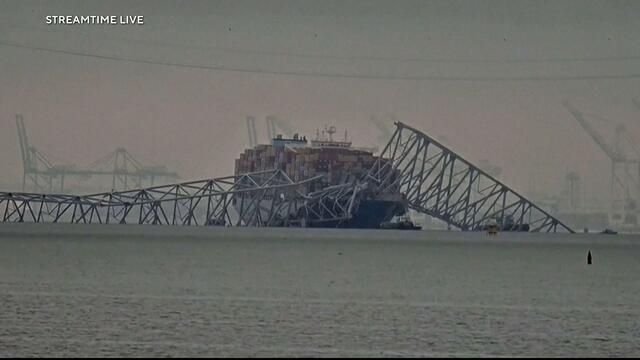▶ Watch Video: Investigation into how ship lost power before bridge collapse
Shocking video showed the moment a massive cargo ship collided with Baltimore’s Francis Scott Key Bridge early Tuesday morning, sending parts of the decades-old suspension bridge, along with people and vehicles, into the Patapsco River.
Six people who were on the bridge are missing and presumed dead, officials said late Tuesday. Two others were rescued from the water. All eight were construction workers who were repairing potholes on the bridge, officials said. There were 22 Indian nationals, including two pilots, aboard the cargo ship.
Investigators and officials are now crafting a timeline of events, including what caused the Singapore-owned vessel, called the Dali, to hit the bridge just minutes after leaving port. Here’s what we know so far.
What caused the Dali to slam into the Francis Scott Key Bridge?
The Dali, which was chartered by shipping giant Maersk and operated by Synergy Marine Group, hit the Francis Scott Key Bridge shortly after leaving the Port of Baltimore.
An unclassified memo issued by CISA, the Cybersecurity and Infrastructure Security Agency, said the ship reported losing propulsion. Maryland Gov. Wes Moore said the ship’s crew reported a “power issue.” A spokesperson for the National Transportation Safety Board, which is investigating the crash, said the agency still needs to verify that the Dali lost power before striking the bridge column.
Two U.S. officials told CBS News multiple alarms rang out on the ship, alerting pilots and crew to an issue on board. The crew ran several system tests to attempt to remedy the loss of propulsion from the motor, but the tests proved unsuccessful. At that point, the ship’s pilots alerted the Maryland Department of Transportation and the Maryland Transit Authority.
That alert allowed local officials to stop traffic on the bridge and likely saved lives, officials said.
The ship’s crew tried to deploy the anchor, though it remains unclear how much progress was made, multiple officials said. The massive ship is over 900 feet long and was moving at about 8 knots, or just over 9 miles per hour. Authorities said that speed is considered “very rapid.”
Captain Michael Burns, executive director of the Massachusetts Maritime Academy’s Maritime Center for Responsible Energy, told CBS Boston that stopping a cargo ship is difficult, especially in such a short time.
“It’s extremely challenging, and takes years of experience and training in order to be able to do this safely,” he said. “It can take up to a mile for some of these ships to get stopped, depending on the circumstances, so we really need to think well out, miles ahead of the ship.”
Why did the Dali lose propulsion?
It’s not clear what caused the vessel to lose propulsion, officials said.
A spokesperson for the NTSB told CBS Baltimore that it had collected the ship’s data recorder, and would review and analyze the material there to determine what happened aboard the vessel in the moments before the collision.
That data recorder will also be used to establish a timeline of events.
What happens when a ship loses propulsion?
James Mercante, the president of the New York Board of Pilot Commissioners, told CBS News that a ship that has lost steering and power is essentially “a dead ship just being carried by the current or its own momentum.”
He highlighted a moment in the video of the crash that appears to show a “big, big puff of black, real dark black smoke” which might indicate that the vessel’s power was “restored at the last minute” and that the pilot was “attempting to make an emergency maneuver” to avoid hitting the bridge. However, he emphasized that it would be difficult to stop the massive cargo ship, especially in such a short time.
“It would take quite a while — probably the length of five [or] six football fields — to bring that ship to a stop, even after dropping the anchors, because of its power and momentum,” said Mercante. “This is a behemoth.”



































